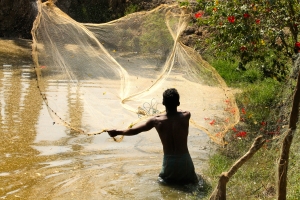Immunizing natural disaster impacts with natural infrastructure
Location: New Delhi, India. 6th May 2014
Mangroves for the Future (MFF), a regional initiative implemented by IUCN in India, promotes investment in marine and coastal habitats as necessary, natural infrastructure. In addition to actively restoring and rehabilitating life-sustaining habitats as mangroves and seagrass beds through community-based models, MFF India projects facilitate and guide management and policy towards long-term sustainability of coastal ecosystems.
Orissa, on the east coast of India, has experienced extreme contrasting weather conditions in the past few decades; Kendrapara, where several MFF projects were implemented, has been one of the worst hit districts. Even as the struggle to develop resilience continues, conventional processes of adaptation are proving insufficient. According to local communities and land records from 1930, seven coastal villages, collectively known as Satabhaya, once existed in a corner of Kendrapara. By 2000, five of these villages had been swallowed up by the sea. The remaining two villages (along with several others along the coast) are in danger of a similar fate; they have already re-located numerous times, leaving their original positions approximately 1.5 km inside the Bay of Bengal.
Hard solutions such as sea walls are often the first point of recourse when considering the protection of India’s coastlines to rising sea levels and erosion. Only now is attention being paid to the development of soft solutions such as mangrove forests, against extreme weather events. MFF India, in partnership with The Environment Protection Training and Research Institute (EPTRI) mapped the coastline of Orissa, as well as Karnataka, Kerala, Tamil Nadu, Andhra Pradesh, to understand the current status of existing coastal vegetation (particularly mangroves and associated intertidal flora) and the extent of human activity related impacts on these. Non-mangroves were also documented in the study and provided an additional understanding of the potential for future activities. Efforts at mixing agriculture, plantations and silviculture were documented as success stories, both with regard to protection and with possibilities for livelihood generation. It was observed that beyond the direct actions of the coastal populations, coastal ecological degradation is highly affected by economic activities on the mainland.
Crucially, the project demonstrated the success that could be achieved in minimizing the impact of storm surges inland through the development and careful planning of natural infrastructure; these soft solutions have been globally proven to be sustainable and cost effective. The information and maps provide a useful toolkit for Forest Departments and practioners in developing a framework for increasing resilience of coastal communities to natural disasters.
A version of this article appeared in the March 2014 issue of southasiadisasters.net on Adaptation to Climate Change: Linking DRR with Micro-insurance; a magazine by IUCN member All India Disaster Management Institute (AIDMI)

Fishing in Orissa, Bhitarkanika, Orissa © MFF India, 2013